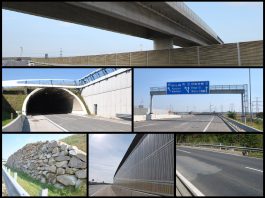Meet the Southern Austrian consulting company specialising in statistical modelling techniques to shore up the resilience of transport infrastructure.
Did you know PEC – Petschacher Consulting are a partner of ours? Discover their partner page and make sure you check out their captivating eBook too!
Modern economies are based on complex networks. As these become more interconnected and more interdependent, they can also become more vulnerable to single points of failure. Energy, information, transport and water networks and infrastructure have been identified as requiring special protection. Much recent attention has been directed at the resilience of energy and information networks; however, this does not diminish the importance of the transport network.
Industrial societies require the easy movement of goods and services: disruption of this movement, even briefly, has severe economic implications. This article will look at methods to avoid and minimise this disruption. We will ask what kind of events can affect the transport network, how we can anticipate them and how the network can be made more resilient.
The transport network can be affected by a wide range of events, ranging from the catastrophic to the mundane. For the purposes of this article we will use a broad definition of ‘event’. We include dramatic events such as hacking, terrorism and natural disasters; but also events such as strikes, heatwaves, as well as the effects of long term infrastructure underinvestment and changes in demographics. We also treat maintenance operations, both emergency and planned, as events. The severity of an event depends on the criticality of the infrastructure it affects; whether it is a local event or affects a wider area, and whether there is permanent structural damage. While it may not be in our power to prevent these events, a resilient network will be able to cope and quickly recover.
PEC is a consulting company, located in Southern Austria, which specialises in the application of statistical modelling techniques to civil engineering. Typically, this means developing a rigorous physical model and then applying appropriate statistical models to play out various scenarios. Initially we applied these techniques to single components and structures, such as bridges, however we are developing models of the wider traffic network. In this article, we will outline our ideas both at the level of individual structures and the overall traffic network. We describe how our integrated approach to instrumentation systems and traffic network modelling techniques contributes to the resilience of transport infrastructure.
Resilience of structures
Bridges and tunnels are chokepoints. Damage, intentional or otherwise, will have consequences for the wider network. These structures therefore require special attention both in the detection and avoidance of events, and in dealing with their effects. PEC has focused on the bridges. Relevant events include the deterioration of the bridge structure, vehicle collisions and weather-related events such as high winds, flooding and landslides.
We have developed two classes of remote instrumentation systems for monitoring the resilience of bridges. Bridge Weigh in Motion (BWIM) systems monitor the speed, type and loading of heavy goods traffic over the bridge. Structural Health Monitoring (SHM) systems monitor structural deformation, weather conditions and the condition of the surrounding soil. The data captured by these systems is passed back to a central server for analysis and archiving.
PEC offers software for traffic analytics based on this data; more recently we have also been active in the development of the ‘digital twin’ concept. The digital twin combines three elements:
- A multiphysics model;
- Historical records of the bridge’s maintenance and loading (from BWIM); and
- Near real-time structural information (from SHM).
The multiphysics model is an ensemble of rigorous physically based models that model distinct, yet coupled, aspects of the bridge structure. The parameters of these models are informed by the historical records and updated by the SHM system. By monitoring and modelling the condition of a structure, we can prevent or at least anticipate events which threaten the resilience of transport infrastructure. That is, we can substitute an unplanned event such as a bridge collapse with a planned event, for example maintenance or load restriction.
Resilience of networks
When an individual structure fails, or is put out of action, it affects the wider network. Equally well, some events (e.g. snowfall) can simultaneously affect many structures across the network. A resilient transport infrastructure network is able to cope with one or more points of failure either due to its intrinsic redundancy, or by having appropriate mitigation strategies. The resilience of a network can be quantified in terms of its:
- Reliability: how frequently does part of the network fail without external agency;
- Vulnerability: how often does the network fail due to external events; and
- Recoverability: how quickly can a network return to full service after an event.
At PEC we are developing systems that model the probability of a structure failing or requiring maintenance and predict the effects over the network. This allows planners to wargame potential strategies for maintenance and for dealing with the resulting disruption to traffic. For instance, if one of our remote instrumentation modules detects land slippage, our component level software will evaluate the severity of the incident, and our network level software will allow planners to assess the effect of maintenance.
We model the traffic network as a series of nodes – bridges, road intersections, tunnels – linked by ‘edges’, or roads. The probability of failure for both nodes and edges is modelled statistically. However, for nodes the models are more complex, incorporating multiphysics models as well as a probabilistic component. In the most serious cases involving multiple failures of critical components, the network will begin to disintegrate into several subnets that are only loosely coupled with one another. Our network models quantify this fragmentation in terms of the network destruction spectrum (or D-spectrum). When we conduct a simulation, we drive our probabilistic models of roads and bridges with Monte Carlo simulations and quantify the resulting evolution of the network.
In conclusion
PEC offers integrated systems which contribute to the resilience of the transport infrastructure. These systems combine instrumentation systems mounted on bridges, multiphysics models of the bridges and models of the road network. By combining models of structures and networks, with up to date information from SHM and BWIM, the network can be simulated under the current weather, traffic and structural conditions. Planners can identify the most likely points of failure, and the most effective mitigation strategies, in near real-time by simulating the current conditions affecting the network.
Dr Markus Petschacher
PEC – Petschacher Consulting ZT-GmbH
+43 (0)4276 33780









